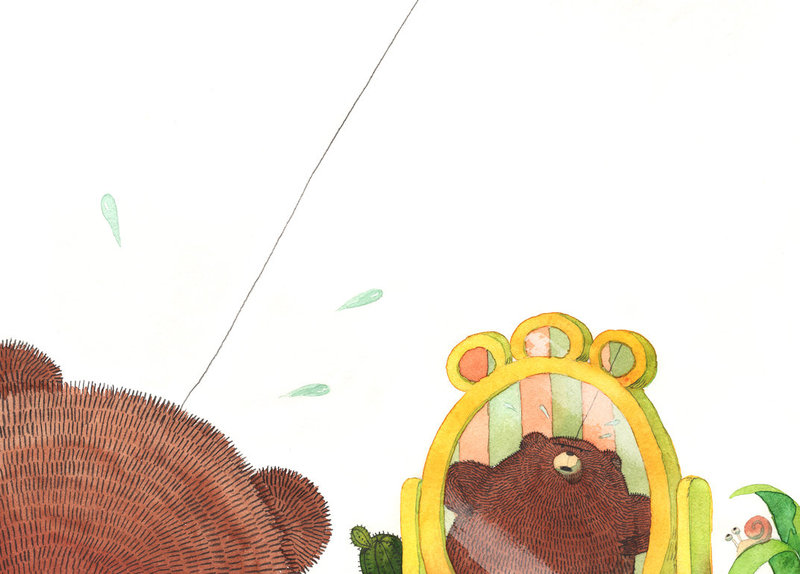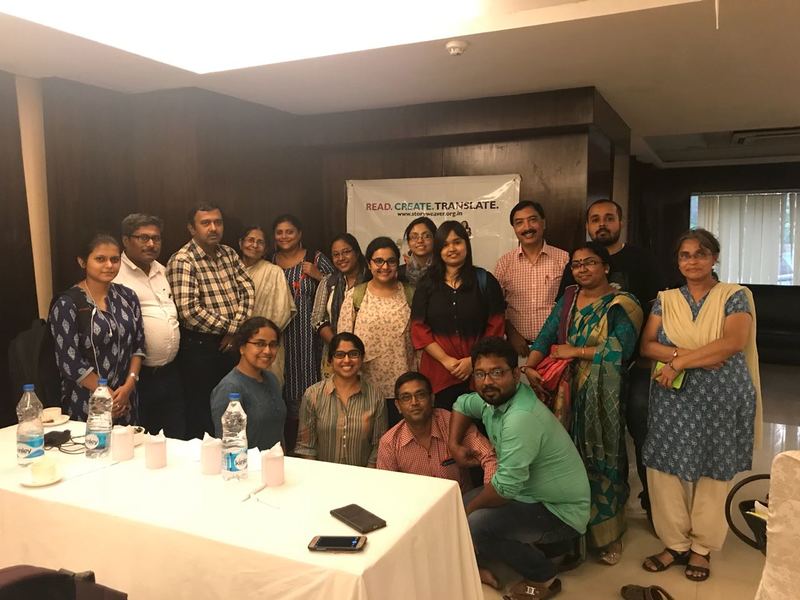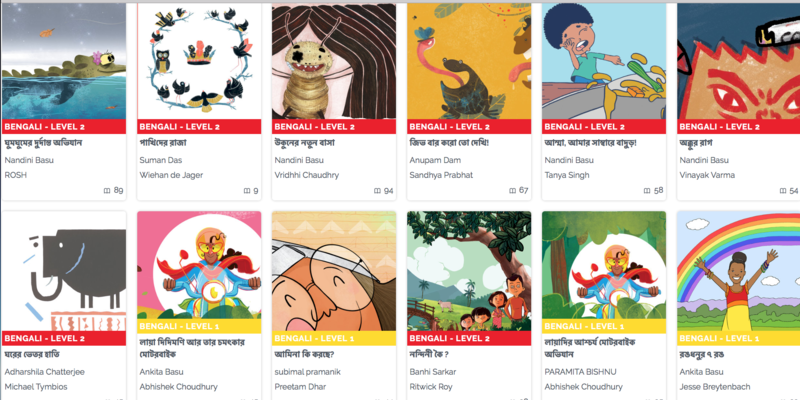ಮಿಂಗ್ ಮಿಂಗ್ ನ ಟೊಂಯ್ ಟೊಂಯ್ ಮತ್ತು ನಗುವಿನ ಗುಟ್ಟು
Posted by Remya Padmadas on December 02, 2019Pratham Books' in-house editor, Hema D Khurshapur, writes exclusively about translations and how they end up giving the feel of the original story, if given a fresh approach. In this blog post, she writes about C.P. Ravikumar's translation of Ming-Ming, Fat Little Bear’s translation into Kannada and the psychology behind laughter.
ಮನುಷ್ಯರ ಮಕ್ಕಳಿಗಷ್ಟೇ ತುಂಟತನ ಸೀಮಿತವೇ? ಪ್ರಾಣಿಗಳ ಮಕ್ಕಳೂ ತುಂಟತನ ಮಾಡಬಹುದಲ್ಲವೇ? ಅದ ರಲ್ಲೂ ಮುದ್ದಿಗೆ ಹೆಸರಾದ ಕರಡಿ ಮರಿಗಳು ತುಂಟತನ ಮಾಡಿದರೆ ಹೇಗಿರುತ್ತದೆ. ಅದೇ ಈ ಪದ್ಯದಲ್ಲಿ ಮೂಡಿ ಬಂದಿರುವುದು. ಕೂದಲಿಗೆ ಉದಾಹರಣೆ ಕೊಡುವಾಗ ನಾವೆಲ್ಲ ಒಂದಲ್ಲ ಒಂದು ಸಲ ಬಳಸಿರುವ ವಾಕ್ಯ, ಅಲ್ಲಿ ನೋಡು ಅವನ ಅಥವಾ ಅವಳ ಕೂದಲು ಕರಡಿ ಕೂದಲಂತೆ ಎನ್ನುವುದು.

Illustrations from the book, Ming-Ming, Fat Little Bear, by Vishnu M Nair
ಕನ್ನಡದಲ್ಲಿ ಕರಡಿ ಮತ್ತು ಕರಡಿ ಮರಿ ಕುರಿತಾಗಿ ಬಹುತೇಕ ಮಕ್ಕಳು ಕೇಳಿರಬಹುದಾದ ಒಂದು ಕವನ, ಒಂದು ಕತೆ ಇದೆ. ಕವನ ಅಂದ್ರೆ ಅದು ಬೇಂದ್ರೆಯವರ ‘ಕರಡಿ ಕುಣಿತ’, ಕತೆ ‘ಜಾಂಬವಂತ’ ಕರಡಿಯ ಕತೆ. ‘ಕರಡಿ ಕುಣಿತ’ ಕವನ ಕರಡಿ ಆಡಿಸುವವನಿಂದ ಶುರುವಾಗಿ, ಮಕ್ಕಳು ಕರಡಿಯನ್ನು ಮುಟ್ಟಿ ನೋಡುವ ಪ್ರಕ್ರಿಯೆ ಮುಗಿದು, ಕರಡಿಯ ಕೂದೆಲೆಳೆ ಮಕ್ಕಳಿಗೆ ದೃಷ್ಟಿಯಾಗದಂತೆ ತಡೆಯುತ್ತದೆ ಎನ್ನುವ ನಂಬಿಕಯೊಂದಿಗೆ ಮುಗಿಯುತ್ತದೆ. ‘ಜಾಂಬವಂತ’ ಕರಡಿಯ ಕತೆಯಲ್ಲಿ ಬರುವ ಕರಡಿ ಮಾತ್ರ ಜೇನು, ಹಲಸಿನ ಹಣ್ಣು ತಿನ್ನುವ ಮುದ್ದು, ಮುದ್ದು ಪ್ರಾಣಿಯಾಗಿ ಮಕ್ಕಳನ್ನು ಸೆಳೆಯುತ್ತದೆ.
ಆದರೆ ಈ ಮಿಂಗ್ ಮಿಂಗ್ ಎಂಬ ಕರಡಿ ಮರಿ, ಇನ್ನೂ ಮುದ್ದು ಮುದ್ದು. ಒಂದು ದಿನ ಬೆಳಗಾಗಿ ಎದ್ದು ನೋಡಿದರೆ ಮರಿಯ ತಲೆಯ, ಮೈಮೇಲಿನ ಕೂದಲೆಲ್ಲ ನೆಟ್ಟಗೆ ನಿಂತಿವೆ. ಅದಕ್ಕೆ ಏನು ಮಾಡಬೇಕೋ ತೋಚುತ್ತಿಲ್ಲ. ಯಥಾ ಪ್ರಕಾರ ಅಪ್ಪ-ಅಮ್ಮ, ಅಣ್ಣ-ಅಕ್ಕ, ದೊಡ್ಡಪ್ಪ-ಚಿಕ್ಕಪ್ಪ ಎಲ್ಲರೂ ಒಂದೊಂದು ಸಲಹೆ ಕೊಡುವವರೇ. ಎಲ್ಲರ ಮಾತು ಕೇಳಿ ತಲೆ ಚಿಟ್ಟು ಹಿಡಿದು ಮಲಗುವ ಕರಡಿ ಮರಿಯ ಕೂದಲು ಮತ್ತೊಂದು ಬೆಳಗ್ಗೆ ಎದ್ದು ನೋಡುತ್ತಲೇ ಮೊದಲಿನಂತಾಗಿ ಬಿಟ್ಟಿರುತ್ತದೆ.
ಇಂಗ್ಲಿಷ್ ನಲ್ಲಿ ಎಲ್ಲವೂ ಸರಿ ಎನ್ನಿಸಿಯೇಬಹುದಾದ ಅಥವಾ ಹಾಗೆಂದು ನಾವು ಭಾವಿಸುವ ವಾಕ್ಯ ರಚನೆಗಳನ್ನು ಕನ್ನಡಕ್ಕೆ ತರುವಾಗ ಎದುರಾಗುವ ಸಮಸ್ಯೆಗಳು ಒಂದೆರಡೆಲ್ಲ. ಅದು ಅನುವಾದ ಪ್ರಕ್ರಿಯೆಯಲ್ಲಿ ತೊಡಗಿ ಕೊಂಡವರಿಗೆಲ್ಲ ಗೊತ್ತಿರುವ ವಿಷಯ. ಈ ಕವನವನ್ನು ಕೂಡ ಇಂಗ್ಲಿಷಿನಲ್ಲಿ ಓದುವಾಗ ಚೆಂದ ಎನಿಸುವ ಪ್ರಾಸಗಳನ್ನು ಕನ್ನಡಕ್ಕೆ ತರುವುದು ನಿಜಕ್ಕೂ ಸ್ವಲ್ಪ ಕಷ್ಟದ ಕೆಲಸ. ಕವನ ವನ್ನು ಟ್ರಾನ್ಸ್ ಫಾರ್ಮ್ ಮಾಡದೇ ಅನುವಾದದಲ್ಲಿ ಸ್ವಲ್ಪ ಮಟ್ಟಿನ ಸ್ವಾತಂತ್ರ್ಯ ವಹಿಸಿ ಒಂದೆರೆಡು ವಾಕ್ಯ, ಒಂದೆರೆಡು ಸಾಲುಗಳನ್ನು ಸೇರಿಸುವ ಮೂಲಕ ಕವನವನ್ನ ಕನ್ನಡದ್ದೇ ಆಗಿಸಿದ್ದು ಅನುವಾದದ ಮಟ್ಟಿಗೆ ಒಳ್ಳೆಯ ಪ್ರಯತ್ನ. ಓದುತ್ತಿದ್ದರೆ ನಗುವನ್ನು ತಡೆಯಲು ಆಗದ ಕೆಲಸ. ಇಂತಹ ಒಳ್ಳೆ ಪ್ರಯತ್ನಕ್ಕಾಗಿ ಅನುವಾದಕ ಸಿ.ಪಿ.ರವಿಕುಮಾರ್ ಅವರಿಗೆ ಅಭಿನಂದನೆಗಳು.
ಬರೀ ಮಿಂಗ್ ಮಿಂಗ್ ಎಂಬ ಮುದ್ದು ಕರಡಿ ಮರಿ ಪದ್ಯ ಕನ್ನಡಕ್ಕೆ ಅನುವಾದಗೊಂಡ ಪ್ರಕ್ರಿಯೆ ಚೆಂದವಾದದ್ದು ಅಂತ ಓದಿದರೆ ಸಾಕೇ... ಓದುವಾಗ ಬರುವ ನಗು, ಹುಟ್ಟುವುದು ಹೇಗೆ ಎನ್ನುವುದರ ಬಗ್ಗೆಯೂ ಒಂದು ಕುತೂಹಲವಾದ ವಿಷಯವಿದೆ.

Illustrations from the book, Ming-Ming, Fat Little Bear, by Vishnu M Nair
ನಗು ಹುಟ್ಟುವುದು ಹೇಗೆ?
ಪ್ರಶ್ನೆಗೆ ಉತ್ತರ ತುಂಬಾ ಸರಳ. ಒಬ್ಬ ಹಾಸ್ಯನಟನನ್ನು ನೋಡಿದರೆ ಸಾಕು, ನಮಗೆ ತಿಳಿಯುತ್ತದೆ! ಆದರೆ ನಗೆ ಸಂಕೀರ್ಣ ವಿಷಯ. ನಾವು ಸಹಜವಾಗಿ ಭಾವನೆಗಳನ್ನು ಅಭಿವ್ಯಕ್ತಿಸುತ್ತೇವೆ. ನಗು ಮನುಷ್ಯರ ನಡುವೆ ಮಾತ್ರ ಕಂಡು ಬರುತ್ತದೆ. ಆದರೆ, ಮನಃಶಾಸ್ತ್ರಜ್ಞರು ನಗುವಿನ ಬಗ್ಗೆ ಎರಡು ಮೂಲಭೂತ ಪ್ರಶ್ನೆಗಳನ್ನು ಇನ್ನೂ ಅಧ್ಯಯನ ಮಾಡುತ್ತಿದ್ದಾರೆ. ಒಂದು, ಜನರನ್ನು ನಗುವಂತೆ ಮಾಡುವುದು ಯಾವುದು? ಎರಡು, ನಗುವಿನ ಉದ್ದೇಶವೇನು? ಜನರು ನಗುವಂತೆ ಮಾಡುವ ಅಂಶ ಯಾವುದು ಅಥವಾ ಜನ ಯಾವುದನ್ನು ತಮಾಷೆ ಎಂದು ಪರಿಗಣಿಸುತ್ತಾರೆ ಎಂದು. ಉತ್ತರ ಹುಡುಕುತ್ತಾ, ಆಲೋಚಿಸುತ್ತಾ ಹೋದರೆ ನಾವು ಮನಃಶಾಸ್ತ್ರಜ್ಞ ಅಥವಾ ತತ್ವಜ್ಞಾನಿಗಳಾಗಿ ಬಿಡುತ್ತೇವೋ ಏನೋ?
ಜನರ ಕೆಲವು ಎಡವಟ್ಟು, ವ್ಯಕ್ತಿಯ ದೌರ್ಬಲ್ಯ ಅಥವಾ ಕುಂದು-ಕೊರತೆ, ಕಾಳಜಿಯ ಸಂದರ್ಭಗಳಲ್ಲೂ ಜನರು ನಗುತ್ತಾರೆ. ನಗುವಿನ ಬಗೆಗಿನ ಮತ್ತೊಂದು ವಿವರಣೆ ಎಂದರೆ, ಇದ್ದಕ್ಕಿದ್ದಂತೆ ನೋಡಿದ ಕೆಲವು ದೃಶ್ಯಗಳು ನಗು ಹುಟ್ಟಿಸುತ್ತವೆ. ಅವು ಸಹಜ ಸಂಗತಿಗಳೇ ಇರಬಹುದು ಅಥವಾ ವ್ಯಕ್ತಿಗಳು ಜತೆಗಿದ್ದಾಗ ಕಣ್ಣ ಮುಂದೆ ನಡೆಯುವ ವಿಷಯಗಳಿರಬಹುದು. ಎಲ್ಲ ರೀತಿಯ ನಗುವಿಗೂ ಈ ಸಿದ್ಧಾಂತ ಅನ್ವಯವಾಗುವುದಿಲ್ಲ. ಕಾಮಿಕ್ ನೋಡಿದಾಗ ಉಕ್ಕುವ ನಗುವೇ ಬೇರೆ, ವಿನೋದ ಸಾಹಿತ್ಯ ಅಥವಾ ಘಟನೆ ನೋಡಿದಾಗ ಉಂಟಾಗುವ ನಗುವೇ ಬೇರೆ. ದೈಹಿಕವಾಗಿ ನಗುವಿನ ಅಂಶವನ್ನು ನೋಡಿದರೆ, ನಗು ಒಳ್ಳೆಯದು. ಇದು ನಮ್ಮ ಶ್ವಾಸಕೋಶಕ್ಕೆ ಮತ್ತು ದೇಹಕ್ಕೆ ಬೇಕಾದ ಹೆಚ್ಚುವರಿ ಶಕ್ತಿಯನ್ನು ಒದಗಿಸುತ್ತದೆ. ನಾವು ಸಾಮಾನ್ಯವಾಗಿ ಹೆಚ್ಚು ನಗುವುದು ಒಂದು ಗುಂಪಿನಲ್ಲಿದ್ದಾಗ. ಈ ಸಿದ್ಧಾಂತದ ಪ್ರಕಾರ ಜನರ ನಗುವನ್ನು ನೋಡಿ ಅವರ ವರ್ತನೆಯ ಟಿಪ್ಪಣಿ ಮಾಡಬಹುದಂತೆ!!
Do leave your thoughts in the comments section below. You can also reach out to us through our social media channels: Facebook, Twitter and Instagram.
Be the first to comment.Selected Partners for StoryWeaver Freedom to Read 2020
Posted by Remya Padmadas on February 21, 2020
At StoryWeaver, we believe that every child deserves to have joyful reading material in her mother tongue. To make this a reality, we have been building all-digital libraries in underserved languages through the 'Freedom to Read' campaign.
In November 2019, we opened applications for the 4th edition of Freedom to Read, inviting organisations and individuals to partner with us to achieve our goal: the co-creation of digital libraries in languages with few or no storybooks by February 21, 2020 - International Mother Language Day. Each of these free-to-use digital libraries will contain at least 50 quality-assured books - creating more storybooks, in more languages, that serve more children all over the world.
We are overwhelmed by the response to Freedom to Read 2020. A BIG thank you to the applicants - we are inspired by your work in the field of literacy and language.
Based on our guidelines, relevance of work, and a rigorous evaluation, we have selected 5 organisations and 18 individual Language Champions to collaborate with us to build and share digital libraries in 20 languages.
Here is the list of partners for Freedom to Read 2020:
Partner Organisations
| Target Language | Organisation |
| Amharic | Ras Abebe Aregay Library |
| Bodo, Nepali and Karbi | Pragyam Foundation |
| English-Surjapuri | Azad India Foundation |
| Fijian | Fijian Language Society |
| Hindi-Magahi | Karunodaya Foundation |
Language Champions
| Target Language | Language Champion |
| Amharic | Kaleab Getachew |
| Arabic | Amina Bouiali |
| Chhattisgarhi | Rohit Sharma, Er. Vivek Rathore, Charan Das Mahant |
| Farsi | Marzieh Nezakat |
| Basa Jawa (Javanese) | Theresia Alit, Sigit Apriyanto |
| Kochila Tharu | Sanjib Chaudhary |
| Lepcha | Minket Lepcha |
| Persian | Nazanin Karimimakhsous |
| Rana Tharu | Kamal Singh Rana |
| Setswana | Leelo |
| Sambal | Leo Fordan |
| Sambalpuri | Dron Sahu |
| Sindhi | Bhawana Dhameja P, Bharti Menghani |
| Tu'un savi | Francisco Amado Cruz Ramírez |
We shall be getting in touch with the selected partners to discuss the next steps.
We are so grateful to everyone who applied - thank you once again for your participation, interest and support! We shall do our best to reach out to you to explore alternate ways to collaborate.
Do join the conversation by leaving your thoughts in the comments section below. You can also reach out to us through our social media channels: Facebook, Twitter and Instagram.
Be the first to comment.Translation Musings
Posted by Remya Padmadas on September 29, 2018We're very fortunate to have such an wonderfully enthusiastic community of readers, authors, translators and illustrators. This International Translation Day, we'd like to share with you the reflections of a group of translators who attended our Bengali Hackathon earlier this year. The contributors to this article all belong to the student community. While Sreejita Majumdar did her schooling from Patha Bhavan, graduation from Calcutta University and post graduation diploma in Public Relations and Multimedia. She has also done an internship with the news channel 24 Ghanta and is currently learning Spanish from JU. Her hobby is painting and her passion lies in football, films and animals. Ankita Basu has done her schooling from B.D Memorial and is currently pursuing her graduation from Calcutta University. She's passionate about films, books and writing. Banhi Sarkar has done her schooling from Gokhale Memorial and graduated from Calcutta University. She loves films and books as well and is interested in writing.
A bunch of us got the unique opportunity to take part in a translation workshop as arranged by StoryWeaver on the weekend of 30th June and 1st July, 2018. The group included people from diverse backgrounds, such as school teachers, students, college professors and language enthusiasts. We had a great time translating quite a few stories over the two days and decided to give a feedback on the same so that it helps in further improving the translation workshops to be held in future.

It was a very unique experience in terms of both learning and working on the given stories set to translate. Even for participants in the group who have been to other translation workshops before, this one was more engaging and enjoyable with a much more prompt delivery of the assigned work. We all got to meet a lot of new people with the same interests and passion in the field of translation. The fact that the participants ranged from school teachers to college professors to students made it a very dynamic group to work with. The coordinators provided a very free and relaxed environment, which made the experience all the more pleasurable.
It was definitely a challenge to work on children’s stories. None of us had realized previously that translating for adults and translating for children could be two completely opposite poles of the same spectrum. But working in small teams and pre-assigned two to three stories eased the way. We could engage in discussions, ask for advice when in confusion and help out others, all within the stipulated time. The two days period seemed to fly by, and though it was tiresome, it was equally productive and satisfying.
However, we did face some challenges in the way which led us to discussions on ways to improve the experience even further for future translators. There were certain aspects we all agreed on regarding the difficulties we faced. We realized since our target audience is children, care needs to be taken to make sure that the words we choose not just have literal significance but that they are both easy and understandable and can fall under the regular vocabulary of a child. For example, in this story there were quite a few words that had to be translated keeping in mind the vocabulary of the children of level 2 in the Bengali translation of The Louse's New House.
The Bengali language is so vast, rich and diverse that it becomes a further challenge to aptly translate all kinds of work from English to Bengali across the entire expanse of its existence. Throughout Bengal, there exists numbers of dialects and forms of the language. As a result, it is important to keep in mind that the translated work should be universal in the sense that it can appeal to a child of both the urban city and the rural village within the same state. For example, we faced situations where a particular word may sound totally innocent on hearing at first, but on further probe, we discovered it may have a negative connotation in a different dialect. So a detailed knowledge about such contradictory words and situations need to be there within the team for effective translation. Also, in the following story for example, there was much pondering over the correct translated word of ‘smooth’ in Bengali that could rightfully carry over the intended meaning from the English to the Bengali version of the story Stick Your Tongue Out!
There were quite a few words related to sound that more or less all the teams came across in one or all of their stories during translation. One such example is Miss Laya Starts Her Fantastic Motorbike in Bengali. That’s when we faced difficulty to find the exact word in Bengali that would correspond to the one already used in English. Since it’s quite common to come across such words in children’s stories, we feel it would be great if there was a reference book where all commonly appeared sound words could be listed along with their regional counterparts and their varying connotations. That would save a lot of time and confusion the next time we translate any story containing such words.
Since this is truly a one of a kind endeavour, it would be highly appreciated if more publicity could be done regarding this platform. More schools need to be aware of it so that they can include the exercise of reading translated stories to their children across different classrooms and thereby lead to a much wider readership. As already discussed at the end of our workshops, many teachers who participated in it decided to take it forward to their schools and start a curriculum based on reading of these translated stories to their students.
It would be very effective if the future workshops could involve people from varying regions and state, in short a cross-regional/national workshop where teachers, translators and writers could participate and interact on a much wider scale to bring about more and more significant children’s stories to light. This could lead to a discovery of more unique works, which usually remain confined within the geographical boundaries, and can reach more children beyond language and cultural barriers.It’s important to keep a balance between the variety of stories being translated and worked upon for children. New ideas and concepts are always welcoming, but we could also work on the classics in each language which may be quite famous in that particular language and thus known to the children of that mother tongue but perhaps remain unknown in other languages. This could help translate the works of authors in regional languages as well.

In short, it was a beautiful and cherishable experience that we all hope to continue beyond the workshop in future. We wish all the very best and give our warm wishes to the entire team of StoryWeaver and Pratham Books for their future endeavours.
You can read all the stories translated at the hackathon here.
Be the first to comment.